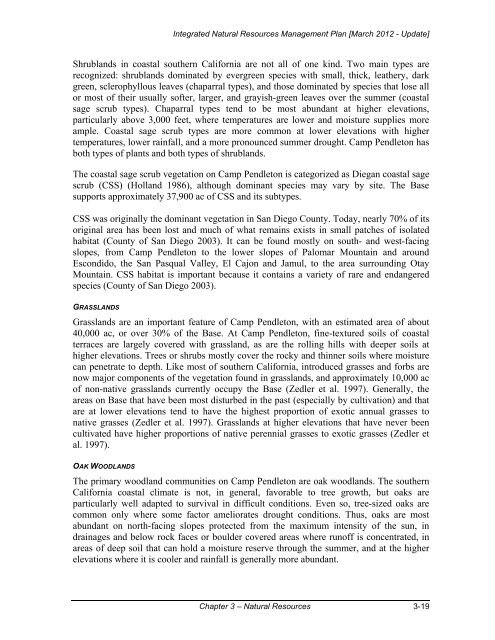Chapter 3 - Natural Resources - Marine Corps Base Camp Pendleton
Chapter 3 - Natural Resources - Marine Corps Base Camp Pendleton
Chapter 3 - Natural Resources - Marine Corps Base Camp Pendleton
Create successful ePaper yourself
Turn your PDF publications into a flip-book with our unique Google optimized e-Paper software.
Integrated <strong>Natural</strong> <strong>Resources</strong> Management Plan [March 2012 - Update]<br />
Shrublands in coastal southern California are not all of one kind. Two main types are<br />
recognized: shrublands dominated by evergreen species with small, thick, leathery, dark<br />
green, sclerophyllous leaves (chaparral types), and those dominated by species that lose all<br />
or most of their usually softer, larger, and grayish-green leaves over the summer (coastal<br />
sage scrub types). Chaparral types tend to be most abundant at higher elevations,<br />
particularly above 3,000 feet, where temperatures are lower and moisture supplies more<br />
ample. Coastal sage scrub types are more common at lower elevations with higher<br />
temperatures, lower rainfall, and a more pronounced summer drought. <strong>Camp</strong> <strong>Pendleton</strong> has<br />
both types of plants and both types of shrublands.<br />
The coastal sage scrub vegetation on <strong>Camp</strong> <strong>Pendleton</strong> is categorized as Diegan coastal sage<br />
scrub (CSS) (Holland 1986), although dominant species may vary by site. The <strong>Base</strong><br />
supports approximately 37,900 ac of CSS and its subtypes.<br />
CSS was originally the dominant vegetation in San Diego County. Today, nearly 70% of its<br />
original area has been lost and much of what remains exists in small patches of isolated<br />
habitat (County of San Diego 2003). It can be found mostly on south- and west-facing<br />
slopes, from <strong>Camp</strong> <strong>Pendleton</strong> to the lower slopes of Palomar Mountain and around<br />
Escondido, the San Pasqual Valley, El Cajon and Jamul, to the area surrounding Otay<br />
Mountain. CSS habitat is important because it contains a variety of rare and endangered<br />
species (County of San Diego 2003).<br />
GRASSLANDS<br />
Grasslands are an important feature of <strong>Camp</strong> <strong>Pendleton</strong>, with an estimated area of about<br />
40,000 ac, or over 30% of the <strong>Base</strong>. At <strong>Camp</strong> <strong>Pendleton</strong>, fine-textured soils of coastal<br />
terraces are largely covered with grassland, as are the rolling hills with deeper soils at<br />
higher elevations. Trees or shrubs mostly cover the rocky and thinner soils where moisture<br />
can penetrate to depth. Like most of southern California, introduced grasses and forbs are<br />
now major components of the vegetation found in grasslands, and approximately 10,000 ac<br />
of non-native grasslands currently occupy the <strong>Base</strong> (Zedler et al. 1997). Generally, the<br />
areas on <strong>Base</strong> that have been most disturbed in the past (especially by cultivation) and that<br />
are at lower elevations tend to have the highest proportion of exotic annual grasses to<br />
native grasses (Zedler et al. 1997). Grasslands at higher elevations that have never been<br />
cultivated have higher proportions of native perennial grasses to exotic grasses (Zedler et<br />
al. 1997).<br />
OAK WOODLANDS<br />
The primary woodland communities on <strong>Camp</strong> <strong>Pendleton</strong> are oak woodlands. The southern<br />
California coastal climate is not, in general, favorable to tree growth, but oaks are<br />
particularly well adapted to survival in difficult conditions. Even so, tree-sized oaks are<br />
common only where some factor ameliorates drought conditions. Thus, oaks are most<br />
abundant on north-facing slopes protected from the maximum intensity of the sun, in<br />
drainages and below rock faces or boulder covered areas where runoff is concentrated, in<br />
areas of deep soil that can hold a moisture reserve through the summer, and at the higher<br />
elevations where it is cooler and rainfall is generally more abundant.<br />
<strong>Chapter</strong> 3 – <strong>Natural</strong> <strong>Resources</strong> 3-19

















